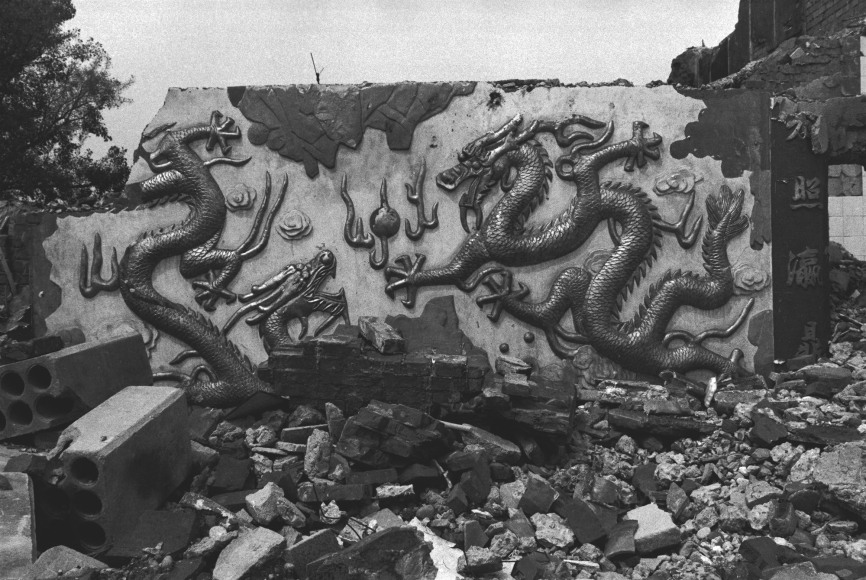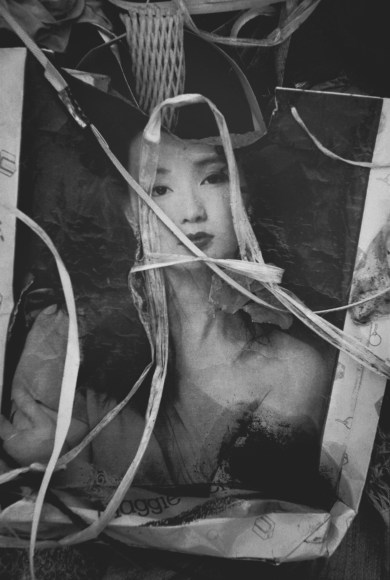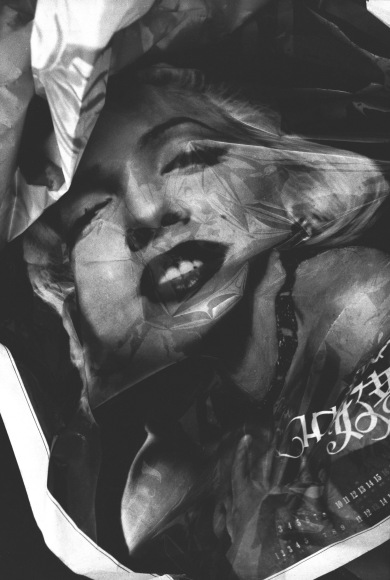Chambers Fine Art is pleased to announce the opening on April 23rd of Rong Rong’s Ruins, Fragments and Wedding Gown Series: 1996-2000. Since 1993 when he moved to the “East Village” in Beijing, Rong Rong has established himself at the center of the world of photography in China. In addition to his own creative photography which continues unabated to the present day, he has also been active as a magazine publisher (New Photo in 1995) and in 2007 was co- founder with inri of the Three Shadows Photography Art Centre in Beijing.
In his first sustained body of work, the “East Village “ photographs dating from 1993-5, Rong Rong focused on the activities of the group of young artists including performances by Zhang Huan and Ma Liuming which have since become key documents in the history of avant-garde performance in the 1990s. Occasional glimpses of the run-down village are distinctly secondary to highly dramatic photographs of the group of rebellious artists who were forced to abandon the village shortly after it attracted the attention of the authorities. Immediately following this series in 1996-98 came the Ruin Pictures in which the focus shifted from human subjects to the urban fabric of Beijing, not the famous monuments but areas of the inner city where traditional dwellings were being demolished on an unprecedented scale.
The romantic appeal of ruins has a long history in the western world, whether the monuments of ancient Rome that inspired so many artists from the Renaissance onward or the remains of gothic cathedrals and monasteries that had such a powerful effect on the imagination of countless visuals artists and writers . Throughout the twentieth century the camera has also documented natural disasters such as the Great Kanto earthquake of 1923 and the man-made devastation caused by the world wars and numerous local conflicts. In contrast in the Ruin Pictures, Rong Rong documents the demolition of traditional dwellings in the name of modernization in central Beijing while endowing his photographs with a high level of cultural and emotive content.
Although some of the best known photographs from the series such as 1997 No. 1 are panoramic views of demolished buildings, the great majority are close-ups of what remains of the interiors. In the rubble-strewn courtyards of recently abandoned hutong the walls of demolished houses are still adorned with treasured family photographs, as well as tattered images of pop stars and pin-ups. Vivid testimony of the lives and interests of the former occupants, the poignancy of these photographs is intensified by awareness that their owners probably had no choice in their relocation. In sub-sets of the Ruin Photographs, Rong Rong frequently photographs the same location from a different angle – 1996 No.10 (1 & 2) - or focuses on a detail from a larger image, a way of exploring the formal possibilities inherent in an essentially formless subject.
Rong Rong continued his exploration of ruins in two further bodies of work, Fragments (1998) and the Wedding Gown (1997-2000). In the former he continued his exploration of found photographs as the subject matter for his own work, using fragments of film negatives cut into tiny pieces that he found in an abandoned house. The clandestine and voyeuristic quality of these images contrasts with the overt romanticism of the three groups of Wedding Gown photographs in which human figures dressed in elaborate costumes enact obscure dramas, culminating in the burning of the dress in Beijing No. 1 (1,2,3,4).
北京前波画廊非常荣幸地宣布将于2011年4月23日起举办《荣荣的废墟、碎片和婚纱系列:1996-2000》。自从荣荣1993年搬进北京的“东村”后,他在中国摄影界为自己树立了其核心地位。除了自己在摄影方面不断地创新,同时他还是《新摄影》杂志的出版者,并且在2007年与映里一起创立了三影堂摄影艺术中心。
1993至1995年期间创作的第一组“东村”系列中, 荣荣着重拍摄了当时的年轻艺术家,包括张洹与马六明的行为艺术,这些作品都成为了记录九十年代中国前卫艺术历史的重要资料。 继“东村”这组作品之后,便是1996-98年的“废墟系列”,同时又是由人文为题材转换到以北京城市结构为主题的过程。这组作品并不是对著名建筑或纪念碑的记录,而是深层次地探索了城市中传统民宿被大面积拆迁的过程。
在西方文艺历史中,对废墟浪漫和伤感的情怀源远流长,古罗马的纪念碑激发了文艺复兴时期众多艺术家们的灵感,而哥特式教堂和寺院也对无数艺术家和作家的想象空间产生了巨大的影响。相反,荣荣的废墟系列却纪录了北京现代化发展中传统民居被拆除的过程,而他的个人情感也融入其中。
几张知名作品(如1996 No.5 (1) 和1997 No.1 )记录了整栋楼的拆迁全景,而更多的作品则是屋内遗留下的物品与墙壁上的特写。在刚刚被拆掉的胡同里的四合院内瓦砾遍地,残墙上仍挂着被遗忘了的家庭珍藏照片,也有遗留着支离破碎的明星画报和图钉。这些作品生动地捕捉了原居住者之前的生活和兴趣,并且强烈地表现出他们搬离时毫无选择的窘状。而在废墟系列的其他作品中,荣荣有时从不同的视角拍摄同一地点 — 如1996 No. 5 (1) 和1995 No.5 (2),有时从全景聚焦到局部,这又是另一种创作方法,从视觉的角度而非形式化的主题来探索各种艺术语言的可能性。
在荣荣碎片(1998)与婚纱(1997-2000)系列的两组作品中,我们似乎可以看到废墟系列的延续。前者利用在废弃房屋中找到的被剪成碎片的电影底片作为主题, 整组作品充满神秘感,仿佛偷窥般的图片而与充满浪漫色彩的婚纱系列形成对比。而后者精心穿着婚纱人物的三组作品里,以燃烧着的婚纱作为整组作品的高潮,演绎着让人难以莫名的戏剧。(Beijing No.1 (1,2,3,4))。



